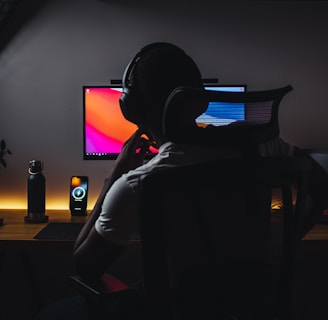The Artist Mindset: How to Be More Productive and Reach Individual Goals
The term "artist mindset" encompasses a unique framework of thought and emotional disposition that distinguishes artistic individuals from those who engage in more conventional modes of thinking. This mindset is characterized by a blend of creativity, passion, and emotional expression, driving artists to approach problems and challenges in innovative ways, allowing them to explore and convey complexities that others may overlook.
Wali Artisan
7/18/20254 min read


Understanding the Artist Mindset
Creativity stands at the forefront of the artist mindset, representing not just the ability to produce aesthetically pleasing works but also the capacity to envision possibilities beyond the immediate. Artists frequently reject established norms and seek to redefine boundaries, resulting in fresh perspectives that can lead to meaningful change. Passion is another defining trait; it fuels an artist's commitment to their craft, driving them to pursue their goals with determination and resilience. Emotional expression, a key component of artistic endeavors, gives artists the ability to communicate profoundly and authentically, forging connections that resonate with diverse audiences.
While the artist mindset builds on innovation and productivity, it can also present unique psychological barriers. Many artists grapple with self-doubt, fear of rejection, and perfectionism, which can hinder their creative process and impede goal attainment. Acknowledging and overcoming these barriers is essential for personal growth and artistic expression. Embracing limitations and developing self-awareness are crucial steps in this journey. By addressing these challenges head-on, artists can harness their intrinsic qualities to strengthen resilience, enabling them to reach their individual goals while contributing significantly to the cultural tapestry of society.
Cultivating Creative Habits
To cultivate a mindset that enhances creativity and productivity, one must prioritize the establishment of effective habits. Creating a dedicated workspace is one of the foundational steps that can significantly influence artistic output. This space should be free from distractions and tailored to the individual's preferences, whether that involves specific lighting, organizational tools, or inspirational elements. A well-designed environment not only helps with focus but also signals the brain that it is time to enter a creative mode.
Establishing a consistent routine plays a crucial role in cultivating creativity. Routines provide structure and predictability, enabling artists to allocate time specifically for creative endeavors. By setting aside dedicated time blocks each day for artistic activities, individuals can develop a flow state that nurtures productivity. Implementing techniques such as the Pomodoro Technique, where one works for a set period followed by a short break, can optimize focus and sustain motivation. This method helps prevent burnout by allowing the mind to rest while also encouraging periods of deep work.
Incorporating regular breaks is equally important, as they can rejuvenate the mind and enhance creative energy. During these breaks, stepping away from the task at hand allows artists to recharge and return to their projects with fresh perspectives. Simple activities, such as taking a walk, practicing mindfulness, or engaging in light or heavy physical exercise, can stimulate new ideas and alleviate mental fatigue.
Ultimately, cultivating creative habits requires intention and practice. By establishing a structured workspace, maintaining a consistent routine, effectively managing time, and incorporating breaks, individuals can develop habits that foster creativity. These strategies are vital in achieving personal goals and advancing one’s artistic journey.
Setting and Achieving Goals as an Artist
Goal setting is an essential component of the artist's journey, particularly when it comes to maintaining productivity and focusing on one's unique vision. A popular framework that artists can utilize when setting their objectives is the SMART criteria: specific, measurable, achievable, relevant, and time-bound. This method supports artists in creating structured goals that align with their aspirations and ensure a clearer path toward achievement.
When establishing specific goals, artists should define what they want to accomplish. For instance, rather than stating a vague intent to "become a better painter," a more precise goal could be "to complete five paintings in the next three months." This specificity not only clarifies the artist's intentions but also provides a tangible target to work towards. The measurability of these goals allows artists to track their progress, making adjustments as needed. Regular assessments of one's work can also cause reflection, enabling artists to evaluate whether their goals continue to reflect their constantly developing vision and aspirations.
Flexibility is another critical aspect of goal setting. As artists progress in their careers, their objectives may shift due to various factors, such as personal growth, changes in artistic medium, or shifts in external circumstances. Being open to revising goals can keep an artist motivated and engaged with their practice. Techniques such as setting aside time for self-reflection or seeking feedback from trusted peers can facilitate this adjustment process significantly.
Moreover, motivation can sometimes wane, especially when facing obstacles. Incorporating motivational techniques, such as visualizing success, creating a dedicated workspace, or celebrating small accomplishments, can help maintain enthusiasm. By integrating these strategies into their goal-setting process, artists can cultivate a proactive mindset, enabling them to navigate challenges while remaining focused on achieving their artistic ambitions.
Overcoming Obstacles and Maintaining Momentum
Artists often encounter numerous obstacles on their creative journeys, which can significantly hinder productivity and impede the achievement of individual goals. Common challenges include self-doubt, burnout, and external pressures that create barriers to artistic expression. Recognizing these hurdles is the first step towards overcoming them. Self-doubt can manifest as negative self-talk, leading to a paralyzing fear of inadequacy. To combat this, artists should practice self-compassion, reminding themselves that growth and improvement come with practice and time. Embracing the notion that every artist experiences challenges can help reduce feelings of isolation and inadequacy.
Burnout, another prevalent issue, arises when artists push themselves beyond their limits without sufficient recovery. This can result in decreased motivation and creativity. To maintain momentum, it is crucial to establish a balanced routine that integrates periods of rest and rejuvenation. Implementing breaks or engaging in activities unrelated to art can refresh the mind, allowing for renewed inspiration. Additionally, artists should seek support from their communities, whether through networking with fellow creatives or participating in workshops. Surrounding oneself with like-minded individuals grants a sense of belonging and can serve as a source of motivation and encouragement during challenging periods.
Maintaining momentum is essential for an artist's progress. One effective strategy is to focus on small wins—simple, achievable goals that can provide a sense of accomplishment. By breaking down larger aspirations into manageable tasks, artists can celebrate each step forward, generating positive reinforcement. Consistent practice, even in brief intervals, can cultivate discipline and keep the creative river flowing. As artists learn to navigate their obstacles and harness the power of community support, they will find that sustained effort leads to remarkable progress. Ultimately, embracing both the struggles and accomplishments of the artistic process can sustain a sense of fulfillment and achievement.
